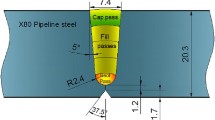Abstract
Stainless steel pipe of type 304 the with a wall thickness of 26.9 mm and the outer diameter 406.4 mm is welded by manual arc welding process. Mechanical properties and fracture toughness of type 304 stainless steel are investigated in the temperature ranging from room temperature to — 162°C. The results obtained are summarized as follows. The tensile strength noticeably increases as the temperature becomes lower while the yield strength is relatively insensitive to temperature. The Charpy impact energy and CTOD values become higher in the case that crack propagation direction is aligned to the transverse axis upon the rolling direction than longitudinal direction. The drop of fracture toughness is associated with the noticeable diminution of plastic component as temperature seduces from room temperature to — 162°C.
Similar content being viewed by others
References
Avery, R. E. and Parsons, D., 1995, “Welding Stainless and 9% Nickel Steel Cryogenic Vessels,”Weld. J., Vol. 74, No. 11, pp. 45–50.
ASTM E 23-96, 1996, “Standard Test Methods for Notched Bar Impact Testing of Metallic Materials,”Annual Book of ASTM Standards, Vol. 03.01.
BS 7448, 1991, “Part I. Method for Determination ofK ic, Critical CTOD and CriticalJ Values of Metallic Materials,”British Standards.
Gordon, J. and Hanson, A., 1965,An Introduction to Stainless Steel, ASM, Metals Park, OH, pp. 137–138.
Harrison, J. D., 1980 “The ‘State-of-the-Art’ in Crack Tip Opening Displacement (CTOD) Testing and Analysis,”Metal Construction, Vol. 12, No. 9, pp. 415–422.
Huang, G. L., Matlock, D. K. and Krauss, G., 1989, “Martensite Formation, Strain Rate Sensitivity and Deformation Behavior of Type 304 Stainless Steel Sheet,”Metall. Trans. A, Vol. 20A, No. 7, pp. 1239–1246.
Ikawa, H., 1972, “Welding Metallurgy of Austenitic Stainless Steel,”Journal of the Japan Welding Society, Vol. 41, No. 2, pp. 9–20.
Jones, D. A., 1992,Principles and Prevention of Corrosion, Macmillian Publishing Co., New York, pp. 291–293.
Kim, C. S., Kim, J. K., Cho, D. H., Yoon, I. S. and Kim, D. S., 2000, “Low Temperature Effects on the Strength and Fracture Toughness of Membrane Material for LNG Storage Tank,” Transactions of KSME, Vol. 24A, No. 3, pp. 710–717.
Kim, H. S., 2001, “The Evaluation of Mechanical Properties and Fatigue Life for Domestic 304 Stainless Steel Used as Membrane Material in LNG Storage Tank,”Transactions of KSME, Vol. 25A. No. 10, pp. 1644–1650.
Lancaster, J. F., 1993,Metallurgy of Welding. Chapman & Hall, London, UK, pp. 152–162, 5th ed.
Marshall, A., 1984, “Effects of Residual, Impurity and Microalloying Elements on Properties of Austenitic Stainless Steel Weld Metals.”Metal Construction, Vol. 16, No. 6, pp. 347–352.
Matsumoto, T., Satoh, H., Wadayama, Y. and Hataya, F., 1987, “Mechanical Properties of Fully Austenitic Weld Deposits for Cryogenic Structures,”Weld. J., Vol. 66, No. 4, pp. 120s-126s.
Mills, W. J., 1997, “Fracture Toughness of Type 304 and 316 Stainless Steels and Their Welds,”International Materials Reviews, Vol. 42, No. 2, pp. 45–82.
Mukai, K., Hoshino, K. and Fujioka, T., 1979, “Tensile and Fatigue Properties of Austenitic Stainless Steels at LNG Temperature,”Tetsuto-Hagane, Vol. 65, No. 12, pp. 1756–1765.
Nakamura, T., Tominaga, M., Murase, H. and Nishiyama, Y., 1982, “Low Cycle Fatigue Behavior of Austenitic Stainless Steel at Cryogenic Temperature,”Tetsu-to-Hagane, Vol. 68, pp. 471–476.
Nishimura, A., Tobler, R. L., Tamura, H., Imagawa, S. and Yamamoto, J., 1998, “Fracture Toughness of Thick-section Weld Joint of SUS 316 at Cryogenic Temperature,” Fusion Engineering and Design. Vol. 42, pp. 425–430.
Read, D. T., Mchenry, H. I., Steinmeyer, P. A. and Thomas, R. D., 1980, “Metallurgical and Nitrogen in Stainless Steel SMA Welds for Cryogenic Service,” Weld. J., Vol. 59, No. 4, pp. 104s-113s.
Tsuzaki, K., Nakanishi, E., Maki, T. and Tamura, I., 1983, “Low Cycle Fatigue Behavior in Metastable Austenitic Steel Accompanying Deformation-Induced Martensitic Transforation,” ISIJ, Vol. 23, pp. 834–841.
Author information
Authors and Affiliations
Corresponding author
Rights and permissions
About this article
Cite this article
Baek, JH., Kim, YP., Kim, WS. et al. Effect of temperature on the charpy impact and CTOD values of type 304 stainless steel pipeline for LNG transmission. KSME International Journal 16, 1064–1071 (2002). https://doi.org/10.1007/BF02984015
Received:
Revised:
Issue Date:
DOI: https://doi.org/10.1007/BF02984015




